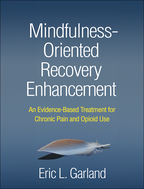Mindfulness-Oriented Recovery Enhancement
An Evidence-Based Treatment for Chronic Pain and Opioid Use
Eric L. Garland
“MORE makes use of a highly nuanced and skillful combination of script-guided formal and informal mindfulness meditation practices, cognitive reappraisal, and strategies for nurturing intimacy with—that is, learning to savor—drug-free moments. MORE’s clinical effectiveness has been rigorously established through sophisticated outcome studies. Given the enormity of the opioid epidemic and the huge number of casualties from the widespread misuse and abuse of such drugs, MORE will be a welcome antidote for decades to come. It offers a portal into a new way of inhabiting one’s moments that can optimize well-being and meaning and minimize dysphoria, addictions of all kinds, harm, and suffering. Of great potential secondary benefit to the reader/therapist are the undoubted health-enhancing and mind-opening effects of practicing regularly with the scripts of the guided meditation practices, and, as discussed in the closing chapter, glimpsing the wisdom dimension of meditative practice as a way of being that transcends imprisoning dualisms.”
—Jon Kabat-Zinn, PhD, founder of Mindfulness-Based Stress Reduction; author of Mindfulness Meditation for Pain Relief
“Research supporting MORE shows its effectiveness, especially for those who may not have achieved treatment goals with other therapy. As a physician whose clinical practice and research focus on helping people with chronic pain and opioid-related issues, I recommend MORE as an intervention; it offers my patients a pathway to safely improve health and quality of life, and take control over their lives.”
—Aleksandra Zgierska, MD, PhD, Professor of Family and Community Medicine, Anesthesiology and Perioperative Medicine, and Public Health Sciences, The Pennsylvania State University
“Guided by neuroscience and rooted in contemplative science, Garland’s analysis of the common mechanisms underlying opioid use and chronic pain is incisive and generative. MORE opens doors to recovery for sufferers whose clinical care has been fragmented and siloed. This accessible treatment manual is backed by 15 years of validation and never takes its focus off the people it is intended to serve. MORE is destined to become the new standard of care for a largely underserved population.”
—Zindel Segal, PhD, Distinguished Professor of Psychology in Mood Disorders, University of Toronto–Scarborough, Canada
“This book will appeal to pain specialists, because Garland—a pioneer in mindfulness-based treatments for pain—is both a scientist and a practitioner. He provides novel scientific insights into how MORE works for patients taking opioids in the context of persistent pain. The book will be of particular interest to clinicians struggling to engage chronic pain patients in meditation or other nonpharmacologic treatments. It is loaded with clinical tips on how to tailor treatment rationales and procedures for patients who vary with regard to their current opioid use, risk factors, or active misuse or addiction. This book is a remarkable resource for any clinician who works with patients suffering from persistent pain or wishes to learn more about the scientific basis of mindfulness-based pain relief.”
—Francis J. Keefe, PhD, Department of Psychiatry and Behavioral Sciences, Duke Pain Prevention and Treatment Research Program, Duke University School of Medicine
Table of Contents
Preface2. The Downward Spiral from Chronic Pain to Addiction
3. What Is MORE and How Can It Help?
4. Anatomy of Mindfulness Meditation
5. Processing Mindfulness in a PURER Way
6. Notes on Delivering the Sessions
The MORE Sessions
- Session 1. Mindfulness of Physical and Emotional Pain
- Session 2. Mindfulness and Automatic Pilot
- Session 3. Reappraising Adversity as a Source of Growth
- Session 4. Savoring Healthy Pleasure, Joy, and Meaning in Life
- Session 5. Mindfulness as Freedom from Craving
- Session 6. Breaking the Chain between Emotional Pain and Craving
- Session 7. Mindfulness to Meaning through Interdependence
- Session 8. Maintaining Mindful Recovery
7. Supplemental Session on Self-Transcendence in Recovery
Appendix. Resources for Learning MORE
References
Index

